Following my research into the crew and their exploits during the war I then had to find out what happened to them afterwards. Therefore here are my findings starting with my father. It took a few years but it was worth all the time, effort and determination.
Leslie Faircloth
Leslie did not fly on any further bombing operations with the RAF. He had taken part in around fourteen combat missions. He became gunnery instructor and travelled widely around RAF bases in the UK training future gunners. He spent time in bases at Dumfries, Manby, Dalcross (Inverness) and at Peterborough as Station Warrant Officer. Les did not see any of his crew after that fateful night in 1944. He tried to contact Joe Sonshine by sending a letter to Joe’s girlfriend in Canada but the letter was returned unopened.
While stationed in Lincolnshire Leslie met his future wife Megan at a dance in Scunthorpe. Megan was visiting family in Scunthorpe from her home in Wrexham. Leslie left the RAF in February 1947, moved to Wrexham, North Wales and married Megan in May in the same year. Their daughter Barbara was born in 1948 but sadly died st just 11 months of age. Their first son Peter was born in 1949 they became publicans at the Cambrian public house in Wrexham town centre. In 1952 they moved to the New Black Horse in the mining village of Rhostyllen near Wrexham and Paul was born there in 1955. They left the pub business in 1964 and moved to a bungalow in the countryside near Mold, 10 miles north of Wrexham. During this period Leslie also had a full time job as a commercial traveller for a local sweet and tobacco wholesaler. He retired as a company director.
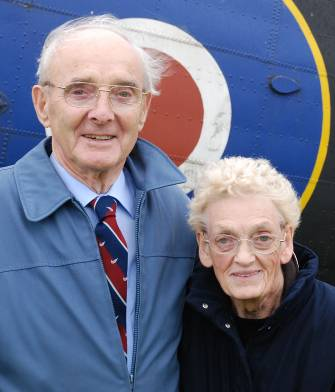
Leslie’s next encounter with a Lancaster was in the early 1980’s when the Battle of Britain Memorial Flight visited the British Aerospace factory at Broughton near Chester. Lancaster PA474 was parked up prior to the flying display and Leslie was invited on board by one of the flight crew. He had forgotten how difficult it was to climb over the wing main spar that bisects the centre of the fuselage. The aircraft is one of only two Lancasters that remain in airworthy condition out of the 7,377 that were built, the other being in Canada. PA474 was actually returning home as she was built at the Broughton works in mid-1945. A few years ago Leslie applied for, and received, a copy of his Royal Warrant to which he was entitled after being promoted to Warrant Officer on 22 September 1945. It was framed and proudly on display at home. Leslie was a member of the Chester and Wrexham branch of the Aircrew Association and they regularly attended lunches with other members and their wives.
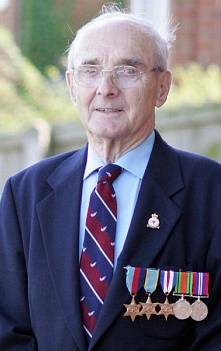
Sadly my father Leslie passed away in November 2016 aged 92. He was in hospital following a minor fall at home and died peacefully in his sleep. He was the last surviving member of the crew of Lancaster ND424. My mother Megan Faircloth also passed away a few weeks after dad. They first met at a dance in Scunthorpe in Lincolnshire in early 1947 and were married in the May, so 2017 would have been their 70th wedding anniversary. They latterly lived in Pentre Broughton near Wrexham and have two very proud sons, five grandchildren and six great-grandchildren.
Joe Sonshine
In October 2006 my father received a letter from Remco Immerzeel in France to say he had seen the ND424 article that I had posted on the BBC People’s War website in September 2005 at http://www.bbc.co.uk/history/ww2peopleswar/stories/32/a5548232.shtml. Remco is a co-contributor to a number of RAF articles on this website. In the letter he told us the sad news that Joe had passed away earlier in 2006.
After an internet search I found a copy of Joe’s obituary from the Toronto newspaper ‘The Globe and Mail’. Sadly Joe had died of cancer on 13th March 2006 in Toronto, Canada aged 85. Its introduction described him as “veteran, entrepreneur and philanthropist”. The obituary also mentioned that Joe’s older brother had been killed while on RAF service so I investigated further. Flying Officer Murray Sonshine was killed (aged 24) during a raid on Leipzig on the night of 19/20 February 1944, just four months before Joe was shot down.
I then searched the internet for an e-mail address for Ruth Pike who wrote the obituary. I found her e-mail address and through this we made contact with Joe’s widow Mildred via e-mail. Mildred and family still live in Toronto. I sent details and crew photographs to Mildred via e-mail and they sent us copies of the book ‘168 Jump Into Hell’. Joe sponsored the publication of this book that tells the story of the POW’s that were sent to Buchenwald concentration camp including himself, Doug and Mike.
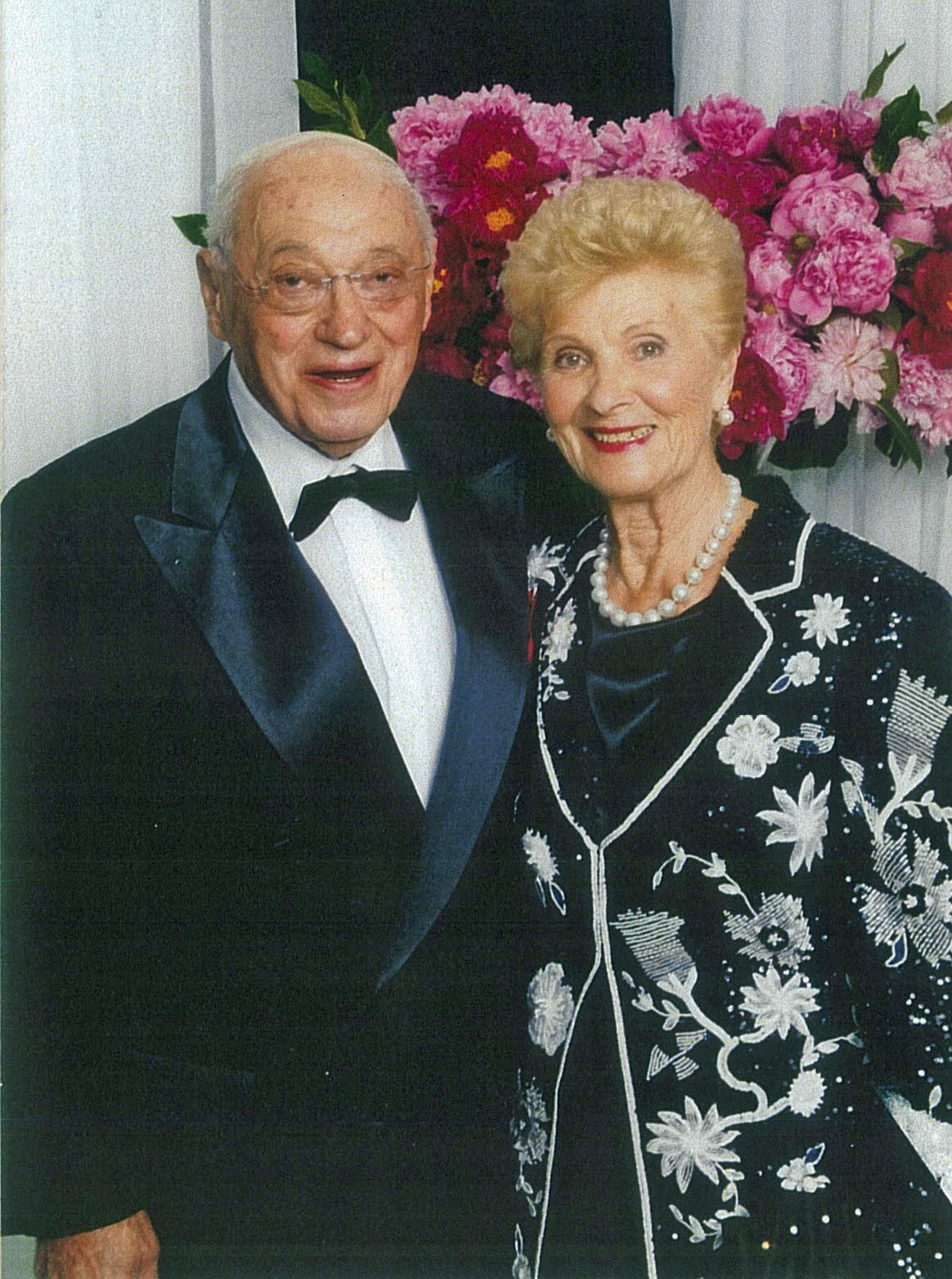
After being released from Buchenwald Joe returned to Toronto and married Mildred Longert, his sweetheart who had waited for him. Just three months before his death they celebrated their 60th wedding anniversary. In 1969 he had founded a family company, Welded Tube of Canada, one of the leading steel tubing producers in North America with plants in South Carolina and Ohio as well as Toronto. The Buchenwald episode left Joe predisposed to various ailments and physical disabilities entailing repeated surgical procedures. Joe supported the start up of The Joseph and Mildred Sonshine Family Centre for Head and Neck Disease.
Doug Jordin
In early 2008 we searched the online UK telephone directory for the name D. Jordin. We found just one entry as it is an uncommon surname and passed the number to Leslie. Leslie called Doug and they spoke for the first time since June 1944 when Les pushed Doug out the stricken Lancaster. Doug and Les met again near Warrington on Sunday 13 July 2008 after a gap of 64 years and 2 weeks.Doug in 2008 It was filmed by the BBC Look North television program and was picked up by BBC Wales, then by news agencies and newspapers all over the world.
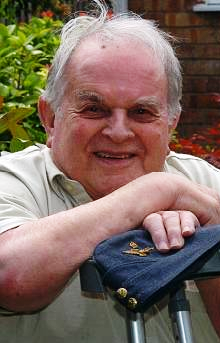
On his return to the UK Doug married his childhood sweetheart Lucy. Doug was a farm manager and he and Lucy lived in Stalmine, near Poulton-le-Fylde in Lancashire. Sadly Doug passed away in February 2010 leaving Lucy, two sons and a daughter. Leslie and family attended the funeral to pay their last respects to his wartime comrade and friend. Over one hundred people attended the service at Poulton-le-Fylde in Lancashire.
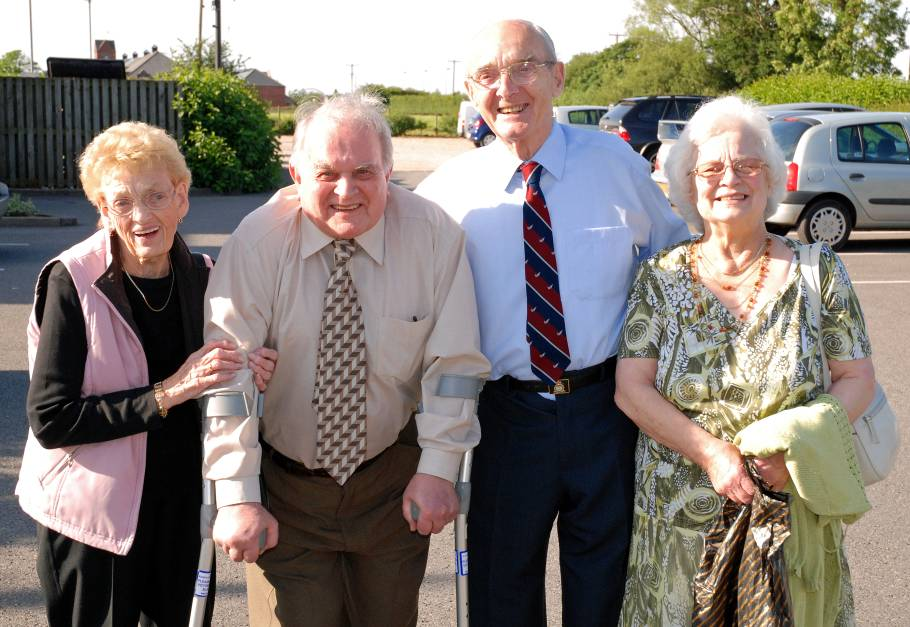
Bob Yates
Following the publicity of Les and Doug’s reunion in July 2008 contact was soon established with Bob Yates who was living in Hammersley near Perth in Western Australia. In December 2008 he wrote to both Les and Doug and they spoke on the telephone.
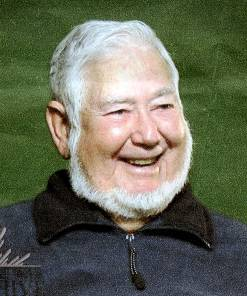
In 1947 Bob married Norma who was from Tasmania and they had three daughters and a son. He also started work with the telephone company in 1947 and had 30 years service in Victoria and Tasmania before he was retired “medically unfit due to war service”. Throughout his adult life he had been in and out of hospital due to the spinal damage he suffered when he hit the ground that night and landed on a gravel path on top of a hill and was knocked out for a time. Bob sent us a web link to ‘almost the full story of my life’ at http://australiansatwarfilmarchive.unsw.edu.au/archive/596-robert-yates. It is the transcription of a series of interviews with Bob about his life and wartime experiences.
Sadly Bob passed away in May 2012 in Perth aged 89. He was survived by his wife Norma, daughters Robyn, Joanne, Helen and son Paul. I have since exchanged e-mails with his brother Don and passed him the link to Bob’s story in the Australian archive as mentioned in the previous paragraph.
John Stephen
Some years ago Leslie saw an obituary entry in the Aircrew Association magazine ‘Intercom’ that he thought may have been for John. Sadly John passed away on 11 December 2000 in Penicuik near Edinburgh, Scotland aged 77. After a series of internet searches I eventually found a reference to his obituary on the web site of ‘The Scotsman’ newspaper and they kindly provided a copy.
John was a well-known socialist and trade unionist who began his working life as a 14-year-old telegraph messenger and ended it as a senior civil servant. Following his RAF service and the demise of ND424 John had been missing for ten weeks when he walked through the door and greeted his wife, Peggy, who had feared the worst.
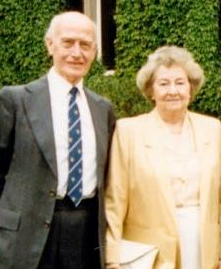
John and Peggy Stephen at their grandson Adam’s graduation in 1994. Photograph Adam Stephen.
Returning from RAF service to civilian life, he immersed himself in his work and trade unionism. He rose to become First Baillie and Deputy Provost of Aberdeen, meeting many famous figures, including the Royal Family. He retired from the Civil Service as a higher executive officer but continued to serve as a Justice of the Peace and heard trials at Midlothian District Court. In retirement he took up golf, playing somewhat badly but with great enjoyment and at considerable speed. A member of the Aircrew Association, John Stephen was a modest gentleman whose sense of fairness and justice was an inspiration to many. John was survived by his wife Peggy, daughter Doris, sons David and Derek, five grandchildren and three great-grandchildren.
In September 2011 I received an e-mail from John’s grandson Adam Stephen then from his elder son David. We exchanged details including telephone numbers so shortly afterwards John’s widow Peggy telephoned Leslie. They last spoke in 1944 when Leslie went up on leave with John to their home to Aberdeen.
David Davies
On return to the UK he went back to 12 Squadron but was soon transferred to 550 Squadron as they were short of experienced men. 550 were also equipped with the Avro Lancaster and were based at that time in RAF North Killingholme in Lincolnshire. David initailly left the RAF in 1947 and applied for grant to attend university. After waiting some time for the grant to come through he re-enlisted in the RAF and was commissioned into the Secretarial Branch. A short while later David married Iris and they had a daughter Janne. David spent most of his second RAF career with Transport Command and travelled widely to bases in the UK and around the world
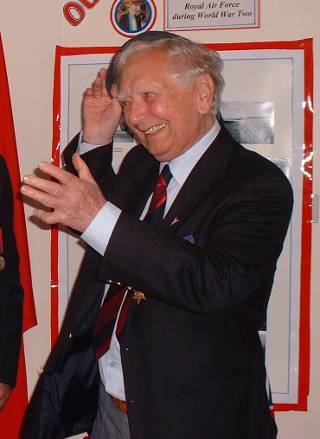
In September 2010 I sent an e-mail to BBC Wales to see if they can help to trace David and they wrote an article for their website but unfortunately no one responded. So in February 2011 I sent an e-mail to the South Wales Argus, the local paper for the area he was from in South East Wales. On 9 February I received a call from Ruth Mansfield, a reporter from the paper, to say an article was to appear the following day. In the Thursday evening I checked our phone and there were a number of messages and missed calls, including one from his sister who still lives in South East Wales. A short while later I answered the telephone and a voice said “Hello, my name is Hugh David Davies and I believe you are looking for me”. After my initial shock wore off we had a great chat about my research and what he has been doing. He provided his e-mail address so I sent him my father Leslie’s telephone number. David called my father Leslie on the Friday and they both said their voices hadn’t changed a bit…in 67 years! I passed Bob’s e-mail address to David and they renewed their friendship, regularly sending e-mails to eachother and exchanging information.
My wife Gaynor and I met David in late April 2011 at his house in Faringdon in Oxfordshire. What a charming gentleman he was and he had some great stories of his time in the RAF. David and Leslie were reunited on 2 November 2013 after a gap of 69 ½ years since they last met in June 1944.
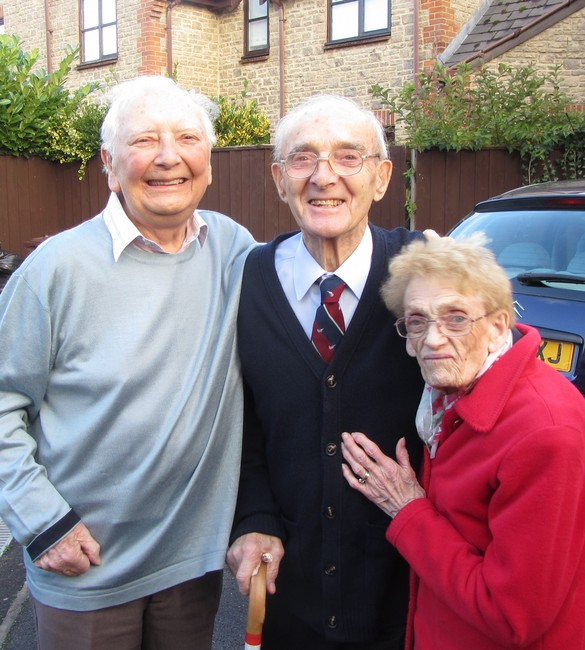
Sadly David passed away in February 2016 aged 90 years. A service was held at his church in Faringdon where he had recently lived and in his home town of Oakdale in south east Wales. It was attended by friends and family including his daughter Janne, granddaughters Hannah and Caroline, six great grandchildren his younger sister Sylvia. Gaynor and Paul travelled down to Oakdale to represent Leslie and Megan who were not well enough to travel.
Mike Guilfoyle
In March 2012 I received an e-mail from Mary Warwick in Australia to tell me that Mike Guilfoyle and his family had emigrated to Australia in the 1960’s and now lived in the Atherton Tablelands region of Queensland. She had seen this website and told me she had spoken to Mike about his wartime experiences as research for a book she was writing. I searched the internet and found an address in Tolga and telephone number for M.A.Guilfoyle but needed further proof, so I sent an article on ND424 and the crew to a local newspaper The Northern Herald.
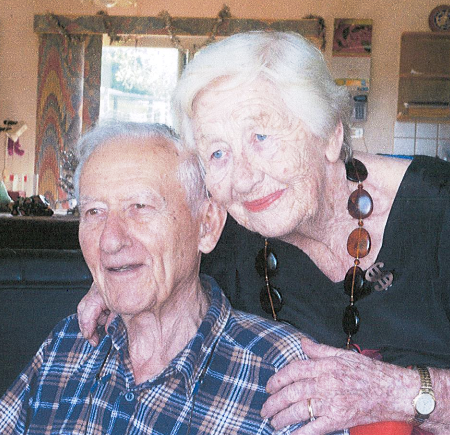
Within a couple of days the e-mails had started to arrive and we made contact with Mike’s family, wife Rosette, daughters Penny and Rosette (‘Junior’) and John, one of his twin sons. We exchanged e-mails and I sent our telephone numbers to Rosette and she called my father Leslie and I for a chat and it was great to hear from her.
Rosette told us that after the war Mike became an airline pilot. They were married and lived in Trinidad for 17 years. Mike retired from British West Indian Airways around 1965 and they decided to emigrate to Australia in 1966. They lived in Sydney for five years where they bought a big news agency and Mike joined the Lion’s International Club. After a few years they moved north where the weather was more clement. He became an estate agent in Cairns, North Queensland, and retired completely in 1981. Whilst living in Cairns they bought a house on 5 acres and started a small business growing Malaysian Dwarf Coconuts trees. As they got older they moved up to the house in the Atherton Tablelands and enjoyed Mike’s retirement.
He continued with the Lion’s Club and served for roughly 40 years. He served in various roles such as President, Secretary, Treasurer, right up to and including District Governor for Northern Queensland and Papua New Guinea, an area as big as England and Scotland. He received many awards and became a Life Member. Sadly Mike passed away in May 2009 and was buried with full honours by the Lions.
